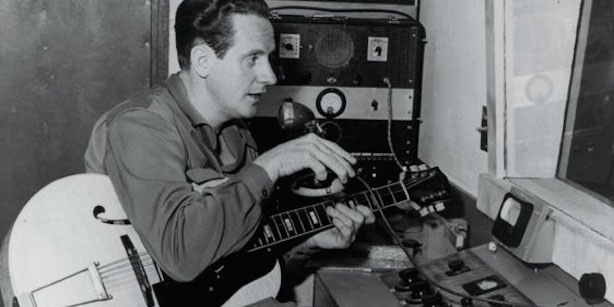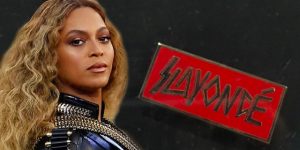 Music
Music
10 game-changing innovations in modern music
by Adria Young
April 28, 2016
These social, political and technological innovations changed music forever.
Ah, music, the cultural force that shapes our lives and is also shaped by our lives. It’s a form of art that is ever-changing, like fashion, the weather, and offensive band names.
In the history of western music, some innovations have had more impact than others, either technical innovations like Moog synths, pedals, and magnetic tape, or social innovations like female hip-hop producers (finally getting props), or political structures like the Federal Communications Commission.
Our sense of “music” is always shifting to new places and changing everything. In the last century, and the two decades of this one, like a choppy avant-garde prog-rock song, we’ve seen enormous change in short bursts of time. So here are 10 essential social, political and technological innovations in modern music.
1. Les Paul’s multi-track recorder
When solid-body electric guitar inventor Les Paul was adding layers of sound to tape, a tricky and corruptible process of recording, he threw his hands in the air like an infomercial mom unable to open a juice pack, sighing, “There’s got to be a better way!”
In 1953, Paul went to a San Francisco tech firm called Ampex and pitched the idea of a multi-track recorder to the manager of special products, Ross Snyder. The idea was a game-changer. By 1955, Snyder and his team produced an eight-track tape recorder, the Sel-Sync machine that they nicknamed “The Octopus,” and sold it to Paul for $10,000.
The invention accelerated music-making every year after its design, and pop music of the 1960s and 1970s is heavily indebted to the ingenious advance in recording technology.
2. Cher’s Auto-Tune
In late 1998, Cher released “Believe,” a post-Sonny Bono dance song that featured one of the first uses of Auto-Tune in pop. Developed by Exxon to monitor seismic activity, the technology was soon co-opted to make the aging vocal chords of a 52-year-old pop singer sound like a robot. It changed music forever.
Soon, Daft Punk was using the technology along with their house-phasers, and then Florida rapper T-Pain gave it a whirl, bringing it to hip-hop. In the height of his codeine mania, Atlanta rapper Lil Wayne released “Lollipop,” and soon everyone south of Kentucky was manipulating their vocals to the point that Young Thug is now incomprehensible without it, and Kanye West’s The Life of Pablo relies on it.
It was different but similar to the earlier effect of the Vocoder, a staple of 1970s experimental electronica like Kraftwerk, Pink Floyd, Giorgio Moroder, and the like.
3. The use of the N-word
It’s hard to imagine rap without the N-word, but its usage began with comedians like Richard Pryor and Paul Mooney, who started repurposing the word in the 1970s. By placing it in a comedic context, its violent and discriminatory origins were reclaimed by the people against whom it was used.
There are still flubs; Patti Smith’s 1978 song “Rock & Roll N*gger” sounds fucking wrong, am I right? The point, however, is that the word slowly took on various connotations, but still belonged to African-Americans. The popularity of NWA, and the Compton rap-group’s gratuitous usage of the N-word, returned the word to a place of violence, as a strong political statement against race relations in Los Angeles.
Over the next decade, the N-word would become not only a statement, but a term of community, endearment and a strong rhyme in rap verses. While radio stations still censor the word from airplay, and while it still occupies a very unusual space (who can use it, really? Who should use it, really?), it doesn’t seem to be going anywhere.
4. Parental Advisory labels
Al Gore’s wife Tipper Gore is a real piece of work, man. Back in 1985, when her husband was still a senator, she formed the Parents Music Resource Centre with a bunch of other “Washington Wives” after being offended by Prince’s “Darling Nikki” from his 1984 masterpiece Purple Rain.
Prince’s explicit use of the word “masturbating” launched the fire of a thousand Parental Advisory Explicit Content labels, and over the next 10 years, artists like 2 Live Crew, Judas Priest, AC/DC, Def Leppard, Madonna and Cyndi Lauper, among many others, would have their artistic expression deemed “offensive.”
They’d often protest the charge in court before being slapped with the iconic label anyway. The precaution almost worked against itself, however, since anything taboo is immediately more enticing, and kids began searching out CDs with the labels because they knew the content was hot as shit. In 2016, because of open-access file-sharing on the Internet and because of the decline of material copies of music, that label is almost irrelevant now.
5. The Internet
The MP3 was introduced to the “world wide web” in 1993 and changed the way that people hear and share music. In the ’90s, the compressed audio file was only one element of the Internet’s irrevocable impact on social and music culture, which is still being theorized and understood today.
What the fuck is the Internet? Not only would forms of delivery change (the introduction of the iPod in 2001 made MP3s mobile), but musicians would lose control of their intellectual property with file-sharing sites like Napster, LimeWire, and Soul Seek, giving way to torrent sites and other forms of copyright law evasion. The guys from Metallica were real dicks about it, as were most artists, and only recently have artists taken back control of their music distribution; Jay Z’s Tidal acquisition is one example.
The “world wide web” is still a “wild wild West,” but some advantages include visibility for artists who otherwise would be remote and inaccessible, and artist accountability in cases like sexual assault or terrible band names. (*cough* Viet Cong)
6. Sampling and looping
After decades of top-of-the-line (read: really expensive) instruments that could record and loop to tape, like the Mellotron or E-Mu systems, Akai released the S900 Vintage Synth Explorer in 1986. The table-top model was the first affordable sampler on the market, and it could store up to 32 samples in its memory.
Soon, other manufacturers like Roland, Yamaha, Casio, and Korg would develop the music pad, making samplers even more more accessible all over the world. These machines enabled sample-based hip-hop, which had emerged most notably in 1970s New York from DJs recording snippets of vinyl to audio mixers, and also in disco music.
Affordability facilitated one of the most popular and creative genres in contemporary American music, and now we can’t even make hip-hop, trip-hop, rap, trap, rap-rock, and indie rock without this production method.
7. Drake and “The 6ix”
Starting from the bottom (Toronto’s affluent Forest Hill) Aubrey Drake Graham rose to Canadian television notoriety on the teen drama, Degrassi: The Next Generation. He began rapping and releasing mixtapes in 2006 that would get attention from BET and eventually Lil Wayne.
By 2009, Drake was working with and writing for some of the biggest names in hip hop, R&B, and rap—Rihanna, DJ Khaled, Kanye West, Birdman, Trey Songz, and more—and over his next few albums, Drake would place Toronto on the rap map, which had, until that point, been mostly known for the likes of Choclair, Jelleestone, and K-OS.
But Drake was different, much larger and inexplicably globally popular. Since founding OVO Sound in 2012, Drake has redefined Toronto to the world. As a representative of the Toronto Raptors, he bestowed the nickname “The 6ix” on the city, and he’s become one of the best-selling Billboard artists of all time (OF ALL TIME). His new album VIEWS is highly anticipated. But he still credits his relationship to Atlanta’s rap icons for making his dreams a reality. On “Summer Sixteen,” he sings, “I might get a key to the city and give it to Wayne.” Nothing’s been the same since.
8. “Cool” politicians
It’s hard to believe that a white dork from Arkansas could be as cool as Bill Clinton, but it happened. Clinton is cool as heck. During his 1992 campaign, the would-be American president appeared on The Arsenio Hall Show playing his tenor saxophone. It was a political move that would secure his election, and it was also the result of his upbringing in a family that actively fought against racial segregation in the South.
Clinton was immensely popular among black Americans, and it’s obvious Barack Obama followed that legacy of electoral trust. We all know Obama is also cool as heck. While his first term was driven by economic repair, he’s been more social in recent years, inviting Kendrick Lamar, J. Cole, Ludacris and more to the White House.
More than any other president, Obama has exuded “coolness,” which is fundamental to his popularity. Sadly, Hilary Clinton dabbed on Ellen, which showed the power of wanting to be ‘cool.’ Unfortunately, she is not.
9. Parody
Imitation is the highest form of flattery, they say, and parody music has capitalized on that old saying for decades. The genre has become a cultural force from its humble beginnings in the Renaissance, and later in sketch comedy, eventually rising from low-brow rip-offs to the well-respected and beloved likes of “Weird Al” Yankovic and Richard Cheese.
More than a tribute, parody songs reinvent a song’s lyrical concept while retaining the sonic structure and Yankovic spent 30 years giving us gems like “Fat” and “Like a Surgeon.”
Last year, his allegedly ‘final’ parody album Mandatory Fun was his first album to reach number one on the Billboard 200 chart, which finally cemented the genre as an actual fucking genre somehow. It might often be really stupid, but it’s always funny.
10. Visual albums
In 2013, on a normal Tuesday morning, Beyoncé dropped her self-titled visual album exclusively on iTunes without any promotion or warning. In the days that followed, it was discovered that the Queen had secretly recorded 14 new songs, accompanied by 17 cinematic videos, over the previous year.
It was a marketing coup that shocked the whole damn world, and redefined the concept of marketing itself—usually, companies over-saturate markets to hype up an album but Beyoncé did the total opposite. Not only did Beyoncé revitalize the ‘music video’ (declining since the Internet made channels like MTV and MUCH almost irrelevant) but it became her go-to marketing strategy.
“Formation” dropped on February 6th in the same way. And she performed it for the first time the next night at the damn Superbowl. Last week, she released Lemonade on HBO with only a few weeks’ notice. Her work is a mix of exclusivity and fine artistry that positions Beyoncé as one of the most important artists of the century. Her videos are perfect compositions.
Tags: Music, Lists, Beyonce, cher, Drake, hilary clinton, les paul, Metallica, N.W.A., Prince, richard cheese, richard pryor, Weird Al





